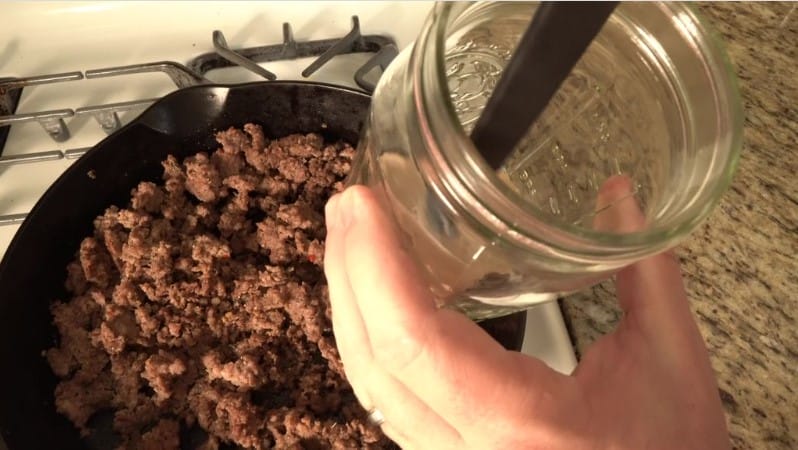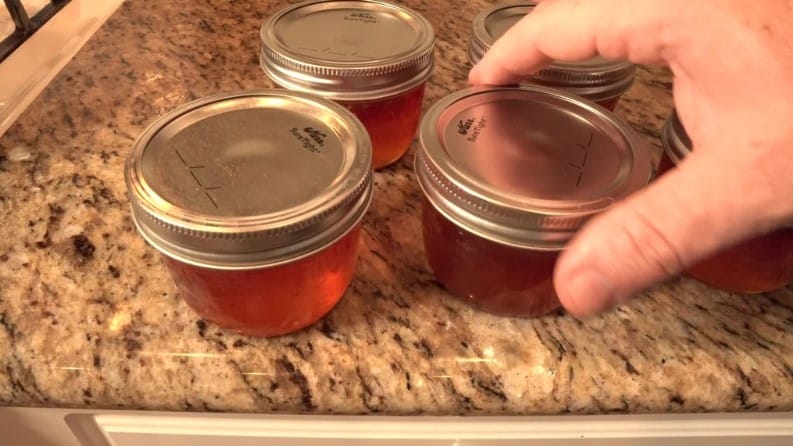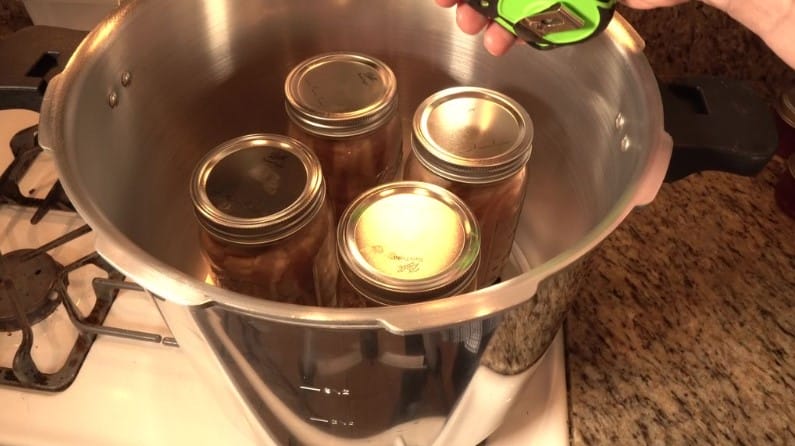How to Store Bacon so it Lasts For Years
In this video, we will show how to can bacon and sausage. This method we’ll show is an efficient way to preserve these meats for extended storage without refrigeration. Canning bacon and sausage gives you flavorful, long-lasting meat whenever you want. By following these combined steps, you can ensure safe and convenient preserved meats for future use. At the end of this video, I’ll also tell you how this process is much older than you might think and perhaps has been done for thousands of years. I will also tell you why people don’t die from canning meat this way and leaving it unrefrigerated in the pantry.
Materials Needed:
- Thick-Cut Raw bacon
- Ground Sausage
- Wide-mouth canning jars (quart)
- Unwaxed Parchment paper
- Distilled vinegar
- Pressure canner – If needing a pressure canner intimidates you a bit, well, we’ll show how to do it safely. Low-acid foods like this require the high temperatures only a pressure canner can give you, as I’ll explain later in this video. I’ll put a link to the pressure canner I am using in the comments below.
- 10-pound weight (for the canner) – This is very standard and will be with any pressure canner purchased. I mention it here because there are different weights available.
Step-by-Step Instructions:
Clean and prepare the wide-mouth pint-sized jars, lids, and bands. The procedure for doing this is to first wash the jars, lids, and bands in hot, soapy water and rinse well. For this bacon, we don’t need the jars to be hot. For some foods, you do. I let my jars cool for easy handling, and so I don’t shock them when I add them to the tap-temperature water bath. Put the lids and bands in a separate saucepan of simmering water until ready to use. Let them sit in there until you are ready to use them.
- Use Thick Cut Bacon for canning. The bacon will lose structural integrity as it cooks in this process, so the thicker, the better.
- Prepare parchment paper sheets. I cut them to be just a little larger than a cookie sheet.
- Lay bacon strips on the parchment paper, with 10-11 slices per sheet.
- Cover the bacon with a second piece of parchment paper that is ½ the width size.
- Fold the bacon in half over this piece of half-sized paper, ensuring it’s even.
- Roll the bacon onto itself, not too tightly, but snug enough to fit into wide-mouth quart jars.
- Place the rolled bacon into sterilized jars with the open part of the parchment paper facing up Push down the parchment paper as needed to get a 1 inch space between the lid and the food.
- Fill the jars with bacon, adjusting the tightness of the roll as needed.
- Wipe the rims of the jars with white vinegar. This will kill off bacteria and clear particles that might inhibit a proper seal.
- Place a sterilized lid on each, and affix the rim to just finger tight.
- Ensure your separator rack is in your canner to ensure the jars are not in direct contact with the bottom of your pot.
- Load the bacon-filled jars into the pressure canner, ensuring they aren’t overcrowded.
- Add enough tap temperature water to ensure a 3-inch depth of water. More than that, and you’ll have difficulty getting it up to temperature. Less than that, and your pressure cooker could run dry. I ensure the proper amount by measuring 3 inches on a spoon and letting that be my guide.
- Vent the canner for 10 minutes before allowing it to pressurize with the addition of the weight.
- Process the jars in a pressure canner at 10-12 pounds of pressure for 90 minutes. Your weight will be dancing. / You will need 15 pounds of pressure for the same amount of time if your elevation is 1,000 or more feet above sea level. This type of canning is considered a “raw pack” in that the meat is raw when the canning process begins. Adjust your temperature down to keep the pressure at a consistent point.
- After processing time is complete, turn the flame off and allow the sealed canner to sit and cool. You may open your pressure canner when the pressure gauge has dropped to zero and the overpressure plug has dropped. You want to give it the full time to cool on its own.
- Carefully remove the jars and place them on the counter. You will see them still actively cooking away.
- Allow the jars to cool naturally, and listen for the plunking and popping sound of the lids.
- A combination of bacon fat and water will be collected at the bottom of the jar and can be used later. I’ll use the almost cup of it I pulled from two jars to season some pinto beans, I will first let soak overnight to soften.
Ground Sausage

For sausage, I like a crumble I can throw into a breakfast scramble or a pasta sauce. To get that old-world sausage flavor, I will add a teaspoon of ground fennel seeds, a teaspoon of ground black pepper, and a tablespoon of dried sage.
- Clean and prepare the wide-mouth pint-sized jars, lids, and bands.
- Cut two round pieces of parchment paper about 1/4″ in diameter wider than your jars.
- Cook the sausage and herbs, but stop right as it browns. The cooking is mainly to maintain separation in the meats, as they will cook alongside the bacon for 90 minutes.
- Strain off grease if there is an excess.
- Place your large piece of parchment paper at the bottom, allowing it to curl slightly up the sides.
- Loosely fill the jars with the crumbled sausage, leaving an inch of headspace. You don’t want to overstuff these because the pressure canner heat must get solidly to the center of the jar. If it’s too tightly packed, the heat may take longer to reach the center and complete the process.
- Place another round piece of parchment paper over the top of the sausage. This will simply hold the contents in place and keep them off the lid area while a suitable seal forms.
- Wipe the jar rims with white vinegar to ensure a clean seal.
- Secure canning lids and bands fingertip-tight.
- Load the sausage-filled jars into the pressure canner. Yes, because the times are the same, you can pressure can the sausage with the jars of bacon, as I did for this video.
- Vent the canner for 10 minutes before adding the weight to pressurize.
- Process the jars in a pressure canner at 10 pounds of pressure for 90 minutes. You will need 15 pounds of pressure for the same amount of time if your elevation is 1,000 or more feet above sea level.
Check the Seals:

For both, and you can pressure can them together because the requirements are the same, you will want to make sure the jars are all properly sealed. The slightly raised part should pop down audibly when cooling, and you will see its depression. Here’s what that depression looks like on some smaller jars of jelly I made, so you can get a visual of what I mean. After cooling everything to room temperature, remove the rings, and the lid should be solidly affixed. Do not store it with the ring. The ring is merely to hold the lid on during the canning process. If you store it with the ring, you might also store moisture under there, which could lead to rust or encourage mold.
COOKING WITH THESE MEATS

Store your canned meats in a cool, dark, and dry place. Crisp bacon in the oven for best results. I transfer it to a cookie sheet and a fresh piece of parchment paper. You can also use a frying pan. Technically, the meats are cooked completely. You could eat them from the jar, but I prefer a crispy bacon. This is where you want the thickest cut of bacon to start because, in the cooking process, the meat will lose some of its strength. Even with the commercial “thick cut” I bought, it was coming apart at the fold. If you are processing your own meat or buying from a butcher, don’t be afraid to ask for an extra thick cut if long pieces are what you are after.
I won’t use the sausage for breakfast but for dinner. The sausage I will scoop out into a cooker, add two cloves garlic, two bay leaves, a can of tomato sauce or two, and a heap of Italian herbs for a marinara ready in just 10 minutes. When ready to use these meats, enjoy them in various recipes or straight from the jar and right off the shelf.
THE HISTORY

The meats can be eaten right out of the can if you have to, but most prefer them warmed. The canning water bath process cooks the meats thoroughly and gives the meats a shelf life of several years. They don’t look the prettiest, but when heated in a pan, the bacon will crisp up and is indistinguishable from bacon you buy raw and cook immediately, but in a fraction of the time. The bacon or sausage grease can be repurposed in several ways. Bacon grease, for instance, has various uses, including enhancing the flavor of dishes such as eggs, greens, and beans, while also being employed as a lubricant, firestarter, leather conditioner, ingredient in homemade soap, gardening pest deterrent, bird feeder coating, and rust preventer. The parchment paper we used here is an excellent fire starter.
When properly canned and stored in a cool, dark, and dry place, bacon or sausage that has been canned can last for an extended period, often several years, even up to a decade or more. It’s essential to check for any signs of spoilage, such as bulging lids, off-putting odors, or unusual appearances, before consuming them.
The first recorded instance of canning meat is credited to Nicolas Appert, a French chef, in the late 18th century, marking the dawn of modern food canning. Additionally, an ancient preservation method known as “pottery cooking,” dating back to ancient civilizations, involved cooking meat and other foods in clay pots, sealing them to ensure preservation, serving as a precursor to contemporary canning practices. Cultures worldwide have practiced pottery cooking for centuries as an early preservation method.
WHY YOU WON’T DIE

Many people, my wife included, are very apprehensive about eating anything I can at home. Admittedly, we are all very accustomed to buying our meat refrigerated, and we seldom give thought to the nitrates and sulfites added to our foods to preserve it, nor do we consider how old the meat really is by the time it gets to our kitchen. It takes at least two weeks from slaughter to supermarket. Realistically, with modern refrigeration, it’s taking much longer than that. You can add 2-6 weeks for cured meats like bacon. The meat in your grocery store could be many weeks old and just recently thawed for sale.
The dreaded B word- Botulism is the big fear. The reason canning, pressure canning, and water bath canning are done is to eliminate the risk of botulism. This is the same practice used by commercial industries to can meats. Basically, water boils at 100 degrees Celsius (212 degrees Fahrenheit) at standard atmospheric pressure. At 10 pounds per square inch (psi) of pressure, water will boil at approximately 239 degrees Fahrenheit (115 degrees Celsius). Botulism is caused by a type of bacteria called Clostridium botulinum. This bacterium produces a potent neurotoxin known as botulinum toxin, which is responsible for the symptoms of botulism when ingested. Botulinum toxin is one of the most toxic substances known to humans. The key is to kill the bacteria that can cause the toxin. You can’t cook the toxin out of food, but you can heat the food long enough at 239 degrees or higher to kill the bacteria that produces the toxin completely. For low-acid foods, a pressure canner is recommended to reach and maintain higher temperatures necessary to destroy the spores of Clostridium botulinum. If you follow the guidelines, pressure canning can be a safe and effective means of food preservation. According to one recent study, in 2018, there were 18 reported cases of possible botulism from food. That’s out of millions of people. So, if you adhere to the food safety guidelines, practice good procedures, and use good equipment, you can enjoy home-canned and preserved foods for years.
As for our bacon, canned bacon, when prepared using proper canning techniques with a pressure canner and mason jars, can have a long shelf life, typically ranging from 2 to 5 years or even longer if stored under appropriate conditions. The shelf life can depend on various factors, including the quality of the canning process, storage conditions, and the bacon’s initial quality.
LINKS:
Pressure Canner – https://www.amazon.com/dp/B083F89ZC1
USDA Guide to Canning – https://www.nifa.usda.gov/about-nifa/blogs/usdas-complete-guide-home-canning









